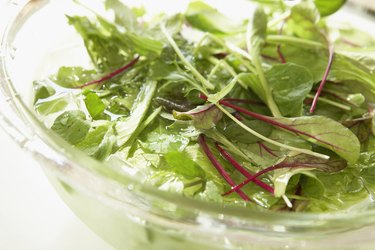
The glycemic index is a tool that ranks carbohydrate-containing foods by how quickly they raise your blood sugar. Although originally devised to help people with diabetes choose the best foods for healthy blood-sugar levels, the glycemic index can also guide carb-conscious dieters in choosing so-called "slow" carbs – those foods that will help you avoid sudden drops in energy that may leave you craving sugary, nutrient-poor foods.
Glycemic Index Basics
Video of the Day
Foods deemed low-glycemic foods, or low GI, rate a score of 55 or lower on the scale. Those foods with a GI number of 56 to 69 are considered medium-glycemic foods, while those 70 and over are deemed high-glycemic foods. Low-glycemic foods tend to be higher in fiber and lower in calories – and include more whole foods than processed – and can help keep you satisfied for a longer period of time. Protein foods like meat and fish contain no carbs, so they don't have a GI rating.
Video of the Day
Low-Glycemic Vegetables
All non-starchy vegetables are low on the glycemic index. Among these are asparagus, bell peppers, bok choy, broccoli, Brussels sprouts, cabbage, cauliflower, celery, cucumber, eggplant, green beans, kale and other greens, as well as lettuce, mushrooms, spinach, tomatoes and zucchini, and each have a GI rating of 20 or less; the serving size is 1 cup, cooked or raw.
Butternut squash, carrots, corn on the cob, green peas, parsnips, sweet potatoes and yams also have a low GI rank, but you'll need to eat a smaller serving. Stick with a half-cup serving of these or have a medium potato or yam.
Low-Glycemic Fruits
Many fresh fruits make the low GI cut, especially apples, grapefruit, oranges, peaches, pears, plums, mango, and kiwi. Serving sizes vary, but have one medium-sized fruit to be on the safe side. For grapes, portion out a cup, and for cherries, serve yourself 20 cherries. Some dried fruits are also considered low-glycemic, including apricots, dates and prunes; have five or six of these to make up your serving. Unsweetened apple, orange, tomato and pineapple juice are low on the scale, too, although they're not as low as the whole fruits they come from. A serving of juice is a cup.
Low-Glycemic Grains
Grains and the food products made from them tend to be higher on the GI scale, but some do fall at the lower end. A cup of cooked barley, brown rice, buckwheat, bulgur or quinoa is low glycemic, as are corn and wheat tortillas. Unsweetened multigrain, oat bran, coarse barley, sourdough and stone-ground whole wheat breads are low GI, but stick to a single slice. Among breakfast cereals, go with a cup of low GI oatmeal. In the pasta category, opt for varieties like vermicelli, fettuccine, macaroni or spaghetti, but keep your portion size to one cooked cup.
Low-Glycemic Legumes and Nuts
Most beans will be your low-glycemic friends. Select a half cup of baked beans, black-eyed peas, black beans, chickpeas, navy beans, kidney beans, lentils, and soybeans; they are all 40 or under on the GI scale. A cup of soy milk is also low GI. For nuts, choose an ounce of cashews or peanuts.
Low-Glycemic Dairy
When you're looking for low-glycemic dairy foods, opt for a cup of plain, low-fat yogurt. A cup of milk falls into the low GI category, too. Some kinds of premium, full-fat ice cream are low-GI, but the more sugar or sugary add-ins ice cream contains, the more likely its GI is higher. Ice cream isn't a healthful food anyway, so is best eaten as an occasional treat.
Tips for Low-Glycemic Eating
You are better off choosing whole foods more often than processed food products, if you want to follow a low-glycemic diet. Whole foods are those in the least-refined state possible, such as fruits and vegetables, lean protein, nuts, legumes and seeds. Limit "white" foods such as white rice, white potatoes and white pasta to small, occasional portions, and swap them for brown rice, sweet potatoes and whole-grain pasta more often. Eat a lean protein such as chicken, fish or beans at each meal, and incorporate healthy fats like olive oil, nuts and avocados into your diet. Remember to watch your portions, too.
Talk to your doctor about the glycemic index, especially if you have diabetes or prediabetes.
- Harvard Health Publications: A Good Guide to Good Carbs: The Glycemic Index
- The Encyclopedia of Healing Foods; Michael Murray, N.D.
- Harvard Health Publications: Glycemic Index and Glycemic Loard for 100+ Foods
- University of Sydney: Search the Glycemic Index
- HelpGuide.org: Diabetes Diet and Food Tips